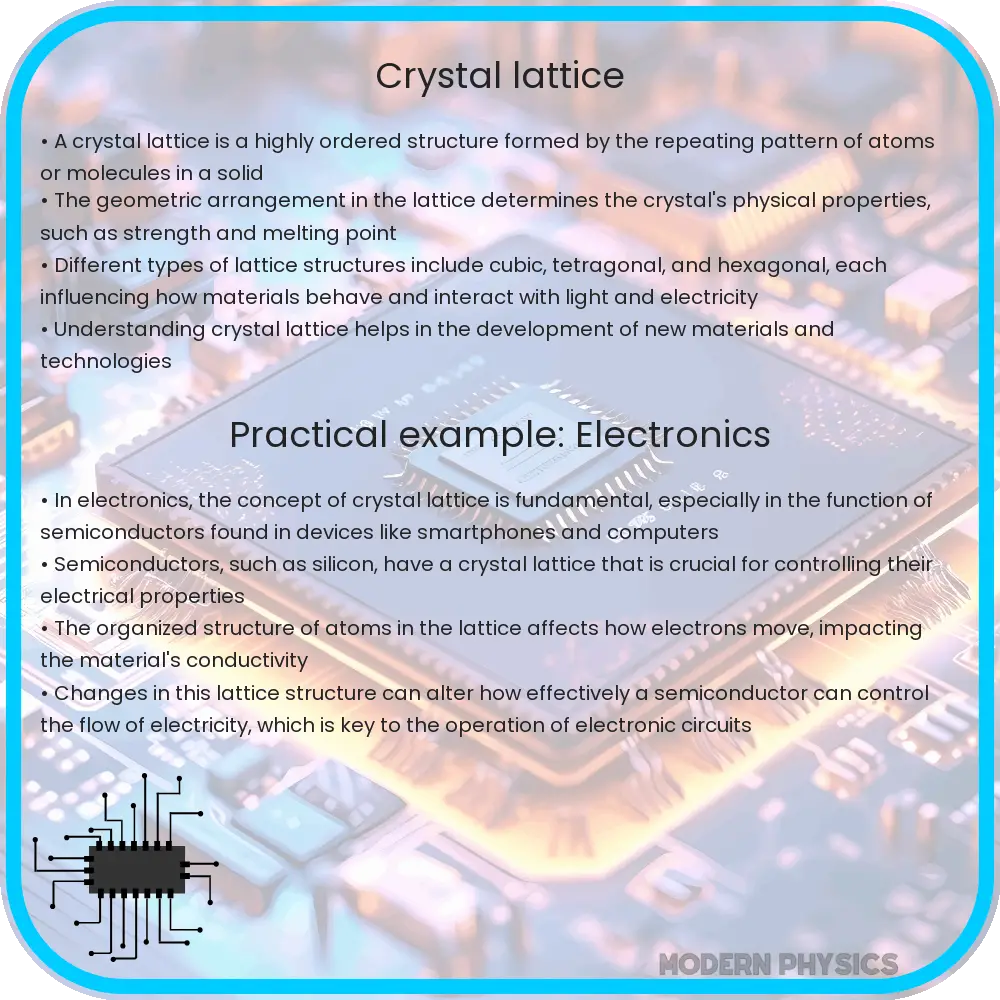Explore the fundamentals of crystal lattice structure, symmetry, and properties, and their impact on material science, with real-world applications.

Understanding Crystal Lattice: Structure, Symmetry, and Properties
The concept of a crystal lattice is fundamental in the study of materials science, chemistry, and physics, providing a framework for understanding the solid state of matter. A crystal lattice can be described as a three-dimensional arrangement of atoms, ions, or molecules in a crystalline material, organized in a repetitive pattern. This structure not only defines the physical appearance of the crystal but also influences its chemical and physical properties.
Crystal Structure and Lattice Types
At the heart of the crystal structure is the unit cell, the smallest repeating unit that represents the entire lattice. These unit cells stack in three-dimensional space to form the crystal lattice. The geometry of the unit cell is determined by its lattice parameters: the lengths of the cell edges (a, b, and c) and the angles between them (α, β, and γ). Crystal structures are broadly categorized into seven crystal systems based on these parameters: cubic, tetragonal, orthorhombic, hexagonal, trigonal, monoclinic, and triclinic.
Symmetry in Crystal Lattices
Symmetry plays a crucial role in defining the crystal structure. It refers to the orderly and repetitive arrangement of the particles in the crystal lattice. The symmetry of a crystal is described by its point group and space group, which collectively determine how the unit cells are oriented and repeated throughout the crystal. The concept of symmetry is pivotal in identifying and classifying crystal structures, influencing their physical and chemical behaviors.
Properties Influenced by Crystal Lattice
The arrangement of atoms within a crystal lattice significantly impacts the material’s properties. For instance, the mechanical strength, electrical conductivity, and thermal conductivity of a material are all influenced by its crystal lattice structure. Materials with a closely packed lattice, such as metals, often exhibit high electrical and thermal conductivity. In contrast, covalent and ionic crystals, with their directional bonds and charged particles, respectively, demonstrate varied behaviors in electrical conductivity and melting points.
The study of crystal lattices extends into the realms of electronic structure and optical properties as well. The band structure of a material, which is crucial for understanding its electrical and optical properties, is directly related to its crystal lattice. Moreover, the optical properties, such as refractive index and absorption, are influenced by the symmetry and spacing of the lattice points.
Advanced Applications of Crystal Lattice Theory
The principles of crystal lattice theory find applications in numerous advanced fields, including semiconductor physics, nanotechnology, and materials engineering. In semiconductor manufacturing, the crystal lattice structure is crucial for determining the electronic properties of materials, which affect their behavior in electronic devices. Similarly, in nanotechnology, the manipulation of crystal lattices at the nanoscale opens up possibilities for creating materials with tailor-made properties, such as enhanced strength or improved electrical conductivity.
Crystal Defects and Material Properties
While ideal crystal lattices offer a framework for understanding material properties, real-world materials often contain defects. These defects, which can range from vacancies (missing atoms) to interstitials (extra atoms inserted into the lattice) and dislocations (disruptions in the regular arrangement of the lattice), play a significant role in determining the physical properties of materials. For example, the presence of certain defects can enhance the material’s mechanical strength through mechanisms like impurity hardening or grain boundary strengthening.
Computational Modeling and Simulation
Advancements in computational methods have enabled scientists to model and simulate the properties of crystal lattices with high accuracy. These computational techniques, such as density functional theory (DFT) and molecular dynamics (MD) simulations, allow researchers to predict the behavior of materials under various conditions, facilitating the design of new materials with desired properties. Computational modeling has become an indispensable tool in materials science, aiding in the exploration of complex crystal structures and the discovery of new materials.
Conclusion
The study of crystal lattices encompasses the fundamental principles that govern the arrangement of atoms in solid materials, offering insights into their structure, symmetry, and properties. From defining the physical and chemical characteristics of materials to influencing their mechanical, electrical, and optical behaviors, the crystal lattice is a pivotal concept in materials science. Advances in computational modeling and the exploration of crystal defects further enhance our understanding and manipulation of materials, paving the way for innovative applications in technology and industry. As we continue to delve deeper into the intricacies of crystal lattices, we unlock the potential to develop materials with unprecedented capabilities, driving forward the boundaries of science and engineering.
